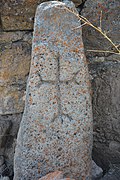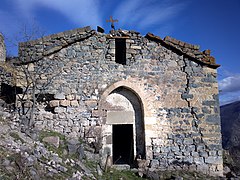Khot, Armenia
Khot Խոտ | |
|---|---|
 View of Hin (Old) Khot | |
39°26′24″N 46°20′10″E / 39.44000°N 46.33611°E / 39.44000; 46.33611 | |
| Country | Armenia |
| Province | Syunik |
| Municipality | Tatev |
| Area | |
| • Total | 17.97 km2 (6.94 sq mi) |
| Population (2011)[2] | |
| • Total | 942 |
| • Density | 52/km2 (140/sq mi) |
| Time zone | UTC+4 (AMT) |
| Khot, Armenia at GEOnet Names Server | |
Khot (Armenian: Խոտ) is a village in the Tatev Municipality of the Syunik Province in Armenia. It is located on the left side of the Vorotan river, 67 kilometers from the regional center of Kapan.[3] On the cliffs below Khot are the ruins of Hin Khot (Old Khot), the previous location of the village until the 1970s.
The village was included under the same name in the Zangezur uezd within the Elizavetpol Governorate of Russian Empire.
During the Soviet years, Khot was a part of the Zangezur province of the Armenian SSR, and from 1930, it was part of the Goris region. Since 1995, the village has been part of the Syunik province of RA, since 2015 it is part of the enlarged Tatev Municipality.
Toponymy
The village was previously known as Khotavan, from Khot + avan (town).[4] The name of the settlement is directly from the Armenian word Khot meaning herbage/grass. According to Heinrich Hübschmann, this is in reference to the rich gardens surrounding old Khot named Khotaget, Khot (grass) + get (river).[5]
History
Khot was first mentioned as a town within the Haband gavar (county) of the Syunik province during the time of the Kingdom of Armenia. In the 11th century, it was mentioned by the Armenian historian Stepanos Orbelian as a tax-paying settlement under the jurisdiction of the Tatev monastery.[4] In 1205, prince Dlen, the son of Khazbak, donated the village of Khot and the large garden of Khotaget to the Tatev monastery. However, it was later taken away from Tatev until 1274, when the prince Tarsayich Orbelian returned it to the monastery.[6] In the medieval period, the castle of Khanapa was located here and the ruins can still be seen today. The oldest monastery of the village was Khoti Vank built in the 5th-6th centuries.[7][8] The Armenian priest and historian Ghevond Alishan referred to it as St. Astvatsatsin. The ruins of the Red Church of the village from the 12th century are preserved in the old cemetery. Traditionally, the bells of this church were known for their powerful sound which is where the name Zangezur, from Armenian zang (bell), is believed to have originated. In the 18th century, the Mrgadzori Khach church was built in the village. According to legend, Mrgadzori Khach was built by an Armenian woman who escaped the harem of the Persian Shah Abbas.[6] By the 19th century, Russian general Yermolov mentions Khot as an Armenian village in the province of Karabakh, conquered from Qajar Iran during the Russo-Persian War (1804–1813).[9]

During the Soviet period, Khot was located in the Goris region of the Armenian SSR. A new settlement was built on a plateau outside of the old city, it contained an 8-year school, medical center, newly planned streets, a cinema, and a library.[6] The old city of Khot was abandoned in the 1960s-70s when its inhabitants were moved to higher ground closer to the main road and utility on flatter land.[10] Ancient cave-dwellings have been preserved in the village and its surroundings.[7]
Demographics
Population
The National Statistical Service of the Republic of Armenia (ARMSTAT) reported its population as 1,079 in 2010,[11] up from 890 at the 2001 census.[12] In the 1823 survey of Karabakh, the population was reported to consist of 37 tax-paying households, all Armenian.[9] According to the Caucasian Calendar in 1912, the population of the village in 1911 was 1,131 people, mostly Armenians.[13] By 1914 it reached 1,240 people, also predominantly Armenians.[14]
| Year | Pop. | ±% p.a. | |
|---|---|---|---|
| 1831 | 173 | — | |
| 1873 | 739 | +3.52% | |
| 1897 | 938 | +1.00% | |
| 1926 | 788 | −0.60% | |
| 1939 | 675 | −1.18% | |
| 1959 | 600 | −0.59% | |
| 1970 | 739 | +1.91% | |
| 1979 | 830 | +1.30% | |
| 1989 | 855 | +0.30% | |
| 2001 | 890 | +0.33% | |
| 2004 | 961 | +2.59% | |
| |||
| Source: [3][4] | |||
Gallery
-
 Mrgadzori khach church
Mrgadzori khach church -
 Ruins of Hin Khot
Ruins of Hin Khot -
 Khatchkar from 1409 in Khot
Khatchkar from 1409 in Khot -
 Hin Khot
Hin Khot -

-
 17th-18th century khachkar in Khot
17th-18th century khachkar in Khot -
 Scenery
Scenery -
 WWII monument in Khot
WWII monument in Khot -
 Hin Khot Church
Hin Khot Church -

References

- ^ "Syunik regional e-Governance System" (in Armenian). Syunik Province provincial government. Click on link entitled "Համայնքներ" (community) and search for the place by Armenian name.
- ^ Statistical Committee of Armenia. "The results of the 2011 Population Census of the Republic of Armenia" (PDF).
- ^ a b Cadastral Committee of Armenia 2008, pp. 97–98.
- ^ a b c Hakobyan, Melik-Bakhshyan & Barseghyan 1988, p. 786.
- ^ Hübschmann 1904, p. 432.
- ^ a b c Hakobyan, Melik-Bakhshyan & Barseghyan 1988, p. 787.
- ^ a b Ambartsumian 1979, p. 81.
- ^ Kiesling & Kojian 2005, p. 55.
- ^ a b Yermolov 1866, p. 141.
- ^ Allen & Holding 2023, p. 352.
- ^ "Marzes of Armenia and Yerevan City in Figures, 2010" (PDF). Statistical Committee of Armenia.
- ^ Report of the results of the 2001 Armenian Census, Statistical Committee of Armenia
- ^ Кавказский календарь на 1912 год [Caucasian calendar for 1912] (in Russian) (67th ed.). Tiflis: Tipografiya kantselyarii Ye.I.V. na Kavkaze, kazenny dom. 1912. Archived from the original on 11 December 2021. p. 218
- ^ Кавказский календарь на 1915 год [Caucasian calendar for 1915] (in Russian) (70th ed.). Tiflis: Tipografiya kantselyarii Ye.I.V. na Kavkaze, kazenny dom. 1915. Archived from the original on 4 November 2021. p. 199
Bibliography
- Allen, Tom; Holding, Deidre (2023). Armenia: with Nagorno-Karabakh. Bradt Travel Guides (6 ed.). Connecticut: Globe Pequot Press. p. 352. ISBN 9781784779436.
- Ambartsumian, Viktor, ed. (1979). "ԽՈՏ [Khot]". Armenian Soviet Encyclopedia (in Armenian). Vol. 5. Yerevan: Academy of Sciences of the Armenian SSR. pp. 80–81. OCLC 22420067.
- Cadastral Committee of Armenia (2008). Dictionary of settlements of the Republic of Armenia (PDF). Yerevan: Center for Geodesy and Cartography" SNCO. Archived from the original (PDF) on 12 September 2014.
- Hakobyan, Tadevos Kh.; Melik-Bakhshyan, Stepan T.; Barseghyan, Hovhannes Kh. (1988). "Խոտ [Xot]". Հայաստանի եւ հարակից շրջանների տեղանունների բառարան [Dictionary of place names of Armenia and neighboring regions]. Vol. 2. Yerevan: Yerevan State University Press. pp. 786–787. OCLC 247335945.
- Hübschmann, Heinrich (1904). Die Altarmenischen Ortsnamen. Mit Beiträgen zur historischen Topographie Armeniens und einer Karte [The old Armenian place names. With contributions to the historical topography of Armenia and a map]. Amsterdam: Verlag von Karl J. Trübner. p. 434. ISBN 9783111258621.
- Kiesling, Brady; Kojian, Raffi (2005). "Syunik Marz". Rediscovering Armenia : an archaeological/touristic gazetteer and map set for the historical monuments of Armenia (2 ed.). Yerevan: Tigran Mets Publishing. p. 55. ISBN 9994101218.
- Yermolov, Aleksey (1866). Opisaniye Karabakhskoy provincii sostavlennoye v 1823 g po rasporyazheniyu glavnoupravlyayushego v Gruzii Yermolova deystvitelnim statskim sovetnikom Mogilevskim i polkovnikom Yermolovim 2-m [Description of the Karabakh province prepared in 1823 according to the order of the governor in Georgia Yermolov by state advisor Mogilevsky and colonel Yermolov 2nd] (in Russian). Tbilisi. p. 141.
{{cite book}}: CS1 maint: location missing publisher (link)
- v
- t
- e

- Achanan
- Agarak
- Aghvani
- Antarashat
- Arajadzor
- Artsvanik
- Bargushat
- Chakaten
- Chapni
- Davit Bek
- Ditsmayri
- Dzorastan
- Geghanush
- Gomaran
- Kaghnut
- Khdrants
- Khordzor
- Nerkin Hand
- Nerkin Khotanan
- Norashenik
- Okhtar
- Sevakar
- Shikahogh
- Shishkert
- Shrvenants
- Srashen
- Syunik
- Sznak
- Tandzaver
- Tavrus
- Tsav
- Uzhanis
- Vanek
- Vardavank
- Verin Khotanan
- Yegheg
- Yeghvard
- Erkenants [hy]





















